No news is good news for the V-22 program. The Bell-Boeing team knows that perception is reality, so they withhold all bad news and create good news. However, info leaked out from concerned junior Marines so Congress launched an investigation a year ago. The V-22 has become a huge embarrassment for the Marine Corps, so Generals are focused on hiding the truth. The head of Marine Aviation refused to provide basic information, like daily readiness reports, so he was literally called on the carpet and threatened with subpoenas. He provided the readiness data, which was far worse than had been reported to the press.
The General hid other serious problems and refused to fully account for all the V-22s Congress has funded. His staff finally admitted that five fairly new MV-22s had been scrapped, even though no mishap reports were ever filed. Others damaged by mishaps were parked and reclassified as "Ground Instruction Aircraft", like the two pictured. The "Block A" V-22s used by the pilot training squadron are less than 8 years old, yet they are in such bad shape that a program to rebuild them has begun. Current production is a year behind schedule, with the last of FY2008 funded aircraft now being delivered.
 Last December, the Congressional Research Service produced an
update on the V-22 program based on open sources. This shed no new light, but did
summarize the June Congressional hearings, which learned that a dozen V-22 parts
failed at less than half their expected life. Last September, the former program
manager tried to put a positive spin on problems, yet admitted
to "Aviation Week":
Last December, the Congressional Research Service produced an
update on the V-22 program based on open sources. This shed no new light, but did
summarize the June Congressional hearings, which learned that a dozen V-22 parts
failed at less than half their expected life. Last September, the former program
manager tried to put a positive spin on problems, yet admitted
to "Aviation Week":
"the MV-22's pitch-control bearings, which were designed to last for the life of the system but have begun to wear out, according to Col. Matt Mulhern, former MV-22 program manager. Also, difficulties in the operation of the engine air-particle separator (EAPS) are driving officials to look for an electric system to replace the hydraulic one. A direct correlation has been found between problems with the EAPS and engine wear and tear. In the short term, vanes fitted into the inlet are expected to better control the flow of air into the EAPS. Program officials are also working on a fix for 85 wiring bundles in the engine nacelles. Dirt mixed with moisture was found to be chafing the wires' coating and eventually the wires themselves."
A Google search of the V-22's contract number N00019-07-G-0008 turns up a dozen recent contracts to fix the V-22's never-ending problems. Each profitable contract was awarded without competitive bidding, because only Bell or Boeing are considered to have the expertise to develop new parts to replace the faulty parts they designed. The spin is that minor flaws are expected when fielding a new aircraft. However, the V-22 first flew in 1989 and went into production in 1997. It is not new, and these problems are not new.
The pilot training squadron has been flying V-22s for a decade now, which is why most of its aircraft are broke down. Pilots and maintainers have known about these failing parts for over a decade, but nothing was done. The are only possibilities are that they couldn't devise solutions or that fixing the problems requires a major redesign of the aircraft. When the truth was reported by the GAO, the V-22 team feigned surprise. They plan to drag out these "fixes" for a few more years until the final V-22 is delivered, while pocketing billions of dollars for the production of ultra expensive parts that last just a few flight hours.
Keep in mind that after two V-22 accidents in 2000 killed 23 Marines, the program underwent an 18-month stand-down to redesign the V-22. In May 2002, at the return to flight ceremony, program manager Col. Dan Shultz proclaimed: "All the problems with this aircraft have been fixed."
What Will Replace the CH-46E?
The CH-46E has been the backbone of Marine Corps' helicopter lift for four decades. The V-22 was sold as its replacement, but can't fully perform its medium lift role. It is unable to perform tricky Landing Zone (LZ) maneuvers, lest it roll over. The V-22 is twice the size of the CH-46E with three times more downwash, so hoist and external load operations are dangerous and rarely attempted. A V-22 can land on dirt or sandy LZs, but the intense downwash caused by its side-by-side rotors and downward engine exhaust make engines sandblast each other. This clogs engine filters (EAPS) and forces fine sand into seams, where abrasive rubbing against wiring and hydraulic lines cause failures. Moreover, its plastic airframe is fragile and basic repairs often require depot level work.
The current defense is that the V-22 is not a helicopter, but provides the Corps with a new capability. While that is debatable, the Marines are quickly losing their helicopter lift capability. Retired Marine Colonel Bill Lawrence, a former V-22 test pilot and the commanding officer of the first V-22 squadron - a test unit, is concerned. After the head of Marine Aviation defended the V-22 last June at a Congressional hearing, Lawrence wrote:
"The question I keep asking is this: What is going to
replace the CH-46? The V-22 was intended to be the answer for that question, but
through the achingly long development process, so many KPPs [Key
Performance Parameters required by the development contract] were unmet and
subsequently changed that it no longer is required to be capable of doing the
things the CH-46 could do, and did, in combat.
LtGen Trautman denies that we did these hairy maneuvers in combat. [in
Vietnam] Au
contraire!! He was not there and does not know. The '46 was described as a
medium transport and compared to the V-22. But the maneuvering that could be
done by the '46 is not in the performance envelope of the V-22. And, to give
tactics its due, maybe those maneuvers will never again be required. But 80% of
combat losses in helicopters in Viet Nam occurred during final to a zone. That's
where we did windup spirals, sideflares, and all the intensive maneuvering
required to survive.
When you test an aircraft, you heavily instrument it. It is covered with strain
gauges that measure tension, structural loads, etc. With the V-22, in early
testing, it was found that those loads were so high that the structural life of
the aircraft would be cripplingly reduced if those maneuvers were practiced, so
no testing has ever been done in those areas and the V-22 NATOPS manual
prohibits such maneuvering.
As I said before, if there is never again a requirement for strenuous combat
maneuvering, the V-22 will probably fit the bill. There are still problems,
however, if today, the V-22 was required to evacuate the American Embassy in Kabul,
Afghanistan, it could go in and land inside the compound. But in those high/hot
conditions, in order to lift a standard load of passengers out, the fuel would
have to be so restricted that the V-22 would have to land within 60 miles of
Kabul to refuel. I consider that a safety issue.
As Rex Rivulo [a rotorcraft expert]
pointed out, there will be incidents of massive power failures ...
always have been, always will be. And, because there is no way to get this
aircraft on the ground through autorotation, folks will die. But that is no
different than any fixed wing. Massive power failure in fixed wing aircraft has
pretty much always meant death for the folks in the back. So, a safety issue,
but not one in my mind that should be a real focus. The failure to have an
autorotational capability was known from the start.
R&M aside, my problems are focused on what a pilot does. I was always a
human factors and ergonomics guy. And pilots are pilots. Remember the B-52 that
went in at the Fairchild airshow in 1994 ... was in a 90 degree angle of bank
when it hit the ground because of aggressive overmaneuvering by the pilot. Why
did he do that? I don't know. He knew better. The world's most experienced F-16
pilot tried to do a split S from 2,500 feet west of Fort Worth with predictable
results. Why did he do that? I don't know. He knew better. Pilots are going to
fly aircraft beyond the published limits in violation of common sense and rules.
In many aircraft, they get away with it. In the V-22, test results say they are
less likely to survive those maneuvers."
Colonel Lawrence's comments about the strain on the V-22s lightweight composite airframe are interesting, especially since he flew the MV-22A. When it became obvious that aircraft could not meet several KPPs, Boeing engineers were tasked to shave empty weight. A couple years later, Boeing proudly announced the MV-22B:
"This fuselage incorporates the lessons we learned in the Osprey's full-scale-development (FSD) phase, as well as some truly significant advances in manufacturing technology. As a result it is 1,541 pounds lighter and $2.07 million (29 percent) less expensive than the earlier FSD design. "The extensive use of automation, Integrated Product Teams and Advanced Technology Assembly system have produced a high-quality, high-precision product and we are seeing outstanding first-time fit and finish to extremely close tolerances." An example of the precision fit of the Osprey's parts is the final alignment of the fuselage sections. V-22 engineers have determined the sections will fit together to a tolerance of .010-inch -- equivalent to the thickness of a matchbook cover."
This made the V-22 even more fragile, yet the V-22 was still unable to meet several of its KPPs, even though OPEVAL tests were conducted by career V-22 pilots from VMX-22 and led by a Marine Colonel, who was later promoted. That second OPEVAL failure may have ended the V-22 disaster, but the test results were pencil-whipped into successes by a retired Marine fixed wing pilot, Tom Carter, posing as an independent civilian evaluator from the Pentagon's DOT&E. He was an open supporter of the V-22 and passed the V-22 after if failed several KPPs. He was so proud of his deception that he bragged on an Internet forum:
Speed, Range, and Altitude Deceptions
Defenders highlight the V-22's supposed greater speed, range, and altitude. Previous G2mil articles have debunked these claims, yet they persist, mostly because Bell, Boeing, and the Marine Corps distribute specs that greatly exaggerate the V-22's capabilities. The V-22 has no greater range than modern helicopters. This was explained by America's leading rotorcraft expert, Dr. J. Gordon Leishman, several years ago: Is there a Case for the Tiltrotor?
The V-22 can fly higher than helicopters, up to 24,000 feet. However, its fragile airframe cannot be pressurized, so pilots must wear arctic gear and oxygen masks when above 10,000 feet, and safety regulations preclude flying more than an hour in those conditions. Passengers cannot be carried above 10,000 feet, so V-22s cruise at 8000 feet, something helicopters can do. In addition, the V-22 can fly high only in the airplane mode. In the helicopter mode, it cannot hover as high as helicopters because it has small twisted proprotors. As a result, helicopters can take off and land vertically at much higher altitudes than the V-22.
Flying at higher altitude to avoid ground fire is not wise
against modern enemies that have medium to high altitude air defense systems. In
those cases, flying low is much safer to deny them a direct shot. In addition, flying high is often
impractical. Basic helicopter missions are less than 50 miles. Such trips take
much longer if the aircraft must spiral up to 8000 feet, then spiral back down into
an LZ. Moreover, only a fool would spiral down into a potentially hot LZ, thus
providing an enemy ample time target the incoming aircraft. Flying
low is faster and safer since it surprises the enemy, saves fuel, and allows a
faster turnaround.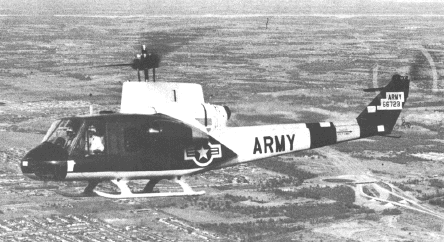
As for speed, the V-22 cannot fly faster if it carries an external load, which it rarely attempts for safety reasons. With internal loads, it must land slower than a helicopter to avoid rolling over, with a firm 800 fpm descent restriction. The V-22 can fly faster than a helicopter, but not two times faster as is often claimed. Boeing lists its top speed at 250 knots, yet back in 1969 a Bell UH-1 "533" modified with two extra engines demonstrated 275 knots. (left) The Marines showed no interest because payload capacity is more important..
Modern helicopters like the CH-53K will cruise at 160 knots, and that new helicopter can carry five times more than the V-22 with far more range, even though both are the same size! The V-22 demonstrated 230 knots during the OPEVAL, but it has since gained some 2000 lbs in empty weight as it was fully outfitted, so it flies at around 220 knots at 3000 feet. However, most lift missions are at much lower altitude, where the V-22's cruise speed falls below 200 knots. Finally, the V-22 cannot load, unload, or refuel faster than helicopters, and can't do anything if broke down in a hangar. So yes, the V-22 is around 30% faster than helicopters, but that is its only advantage. Since it carries less than half the payload of similar size helicopters, it delivers much less cargo per day.
March 2, 2009 CV-22 Mishap Hidden
A routine listing by the USAF's legal office revealed that an Air Force CV-22 suffered a Class A mishap on March 2, 2009. This was not reported to the media, nor to the GAO and Congressional investigators last Spring when they conducted a review of the program. It seems either the incident or the resulting investigation is embarrassing since the report is still pending over a year later. Note that it is the oldest pending investigation.
CWO2 Keith Marine Silenced
Thomas Ricks, of "Washington Post" fame, writes a popular blog at "Foreign Policy" magazine. He posted a series of insightful, first hand accounts of lessons from Afghanistan ,written by a Marine Corps Chief Warrant Officer "Keith Marine." In a Jan 26, 2010 post, the CWO2 stated.
"Not that we can do anything about it but realize it and make adjustments but our pilots and aircraft suck in comparison to the Army and Air Force. I noticed it before when these units have flown for me but not like this time. We used Army guys for some training, along with Marines, prior to D-Day and the differences were very noticeable and undeniable even amongst our own FACs. [Marine pilots serving as ground-based Forward Air Controllers] The Army guys will come in and land at the grid you give them, with very limited dispersion between birds -- allowing you to link up with your other elements, and will set the thing right down on the deck in the inbound flight appearing not to lose much speed. In comparison, Marine pilots will bring in their aircraft and attempt several flaring techniques and then wave off. Sooner or later they will land in the midst of a brown out and probably a few hundred meters off target with dispersion of about ½ click [1000 yards] between aircraft is the norm. Luckily the Army and Air Force guys will drop right where you want them to pick up casualties, we are lucky to have them.
I have heard a lot of excuses on why this is and here are the two most plausible ones. 1) They have superior aircraft with better handling capabilities; 2) Their pilots are pilots, whereas our pilots fill a dozen different billets and get about a tenth of the actual stick time these guys do. Like most of you, I love the Corps and it hurts me to say it but I think we have been chasing the wrong aircraft. We don't need to create a capability; the other branches already have it in the aircraft they use. We need that capability for when they aren't there. You just can't fit a 46 or 53 and definitely not an Osprey [V-22] where these things will land."
That was his last post because he contacted Ricks and told him that he would no longer submit accounts, and asked Ricks not to post some he had already sent. No explanation was provided, so one can only speculate why he was silenced.
The flight restrictions below are from the current V-22 NATOPS (pilot's manual):
VTOL/CONV: Minimum separation is
250 ft cockpit-to-cockpit and 25 ft of step up. During approach and landing
phase, maintain step up until lead lands or maintain 250 ft separation. While
maintaining 250 ft separation, avoid 5 to 7 o'clock position downwind of the
upwind aircraft.
a. Crossovers in descending, turning flight prohibited.
b. Crossovers in descending, wings level flight prohibited with ROD in excess of
500 fpm.
c. Crossovers shall maintain at least 50 ft of step-up.
___________________
These V-22 limits were imposed because the wake or downwash from another aircraft can affect one tiltrotor before the other, causing an instant snap roll and crash. As a result, V-22s must remain a football field apart and fly at different altitudes. A "wave" of V-22s is never more than three aircraft, and only one can take-off or land at a time. Such restrictions do not apply to helicopters.
Army Helos Rescue Marines
The U.S. Army's new CH-47F Chinook is the bigger cousin of the Marines' CH-46E. It has been extensively upgraded since Vietnam. It is 50% smaller than the V-22 (empty weight) yet can lift twice as much and has greater range. It costs one-third as much and with far fewer parts and a stronger airframe, and is mission capable 85% of the time. Actual V-22 readiness rates are spun to the press. The standard measurement of "full mission capable" has been replaced with the vague term "availability" while readiness averages have been replaced with "snapshots." This means the peak of "availability" on a good day in the past couple of months is quoted to the press.
The CH-47F can carry external loads and conduct hoist operations, which the unstable V-22 only attempts in ideal test conditions. A recent USAF CSAR study concluded that hoist operations from the V-22 are not possible, and that V-22s cannot hover safely above 4000 ft. In contrast, the CH-47F can land in smaller LZs up to 10,000 ft., and cause far less a dust storm.
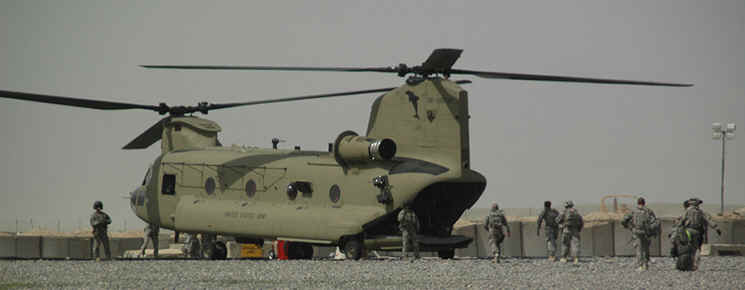
Army helicopters support Marines several times a day in Afghanistan, as this recent picture demonstrates. The Marine Corps has a severe shortage of helicopter lift since half of their CH-46Es have been retired. Congress funded 156 MV-22s for the Marines through FY2009. Only ten are in Afghanistan, where most are broke down, and 10 are aboard ship. None are in Iraq, and none are deployed elsewhere overseas. As a result, the Corps asked the Army for helicopter support in Afghanistan. The Army deployed a helicopter brigade from the 82nd Airborne division, called "Task Force Pegasus" primarily to support the Marines in southern Afghanistan. This was hidden by saying the deployment was an example of "jointness" to support "coalition" forces.
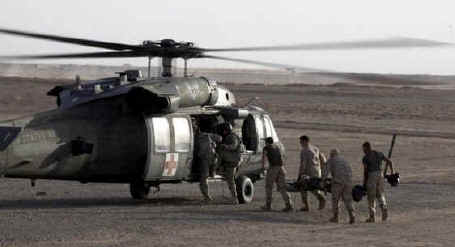 The Marines
rely on the Army for medivacs in Afghanistan, as they did in Iraq.
The V-22 program consumed so much of the Marine Corps' "blue" budget
for decades that no thought was
given to procuring medical evacuation helicopters, like the Army's proven UH-60Q, pictured at left
evacuating a Marine wounded by an IED in Afghanistan in March
2010.
The Marines
rely on the Army for medivacs in Afghanistan, as they did in Iraq.
The V-22 program consumed so much of the Marine Corps' "blue" budget
for decades that no thought was
given to procuring medical evacuation helicopters, like the Army's proven UH-60Q, pictured at left
evacuating a Marine wounded by an IED in Afghanistan in March
2010.
Although the V-22 is 30% faster than the H-60, its large size, limited maneuverability, and intense downwash severely limits its LZ options. Moreover, the UH-60Q is customized for medivac, with better lighting, lockers full of medical supplies, a powerful heating system to prevent shock, with oxygen and chest suction systems. A version of the H-60 is in production for the Navy, so purchasing a "navalized" Marine version has been an option for years. As Marine Corps CWO2 Keith Marine stated about operations in Afghanistan: "Luckily the Army and Air Force guys will drop right where you want them to pick up casualties, we are lucky to have them."
V-22s Self-Deploy -- to a Texas Port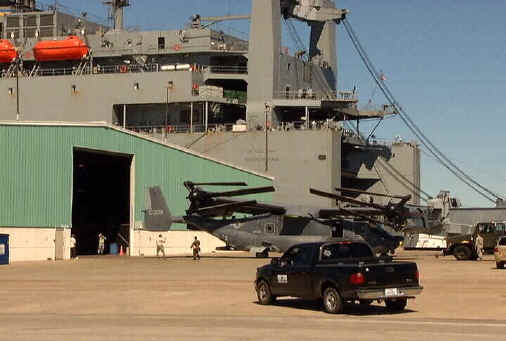
One of the major selling points of the V-22 program was a claim that it can self-deploy overseas, just like an airplane. This has been demonstrated, but is not done today. The Marines have used ships to move their MV-22s overseas.
On March 1, 2010, several Air Force CV-22s self-deployed from Florida to Texas to embark on a ship. They were folded up and preserved for the long journey to Afghanistan. (right) Rather than just flying eastward to Spain, they flew the other direction to south Texas to embark on a transport ship. This was embarrassing for the "Air Force." The similar-sized C-27J STOL transport is the same size as the V-22 and uses the same two engines. It self-deploys overseas since it has twice the range, and half the maintenance problems.
 Helicopters
can be carried inside large transport aircraft, although larger ones require some disassembly. This is
not practical for the V-22, and since flying long distances has proven dangerous, they are moved by ship. The Marine Corps recently shipped CH-53D helicopters to
Afghanistan inside C-17s. (left) These Vietnam-era helicopters were supposed to
retire in 2006, but have remained in service due to the V-22 failure. The
Corps has only around 30 CH-53Ds, which have two engines whereas the newer
CH-53Es have three. The Corps manages to maintain 10 flying in Afghanistan.
These ancient "Deltas" are 50% smaller than the V-22, yet carry more
payload and have more range!
Helicopters
can be carried inside large transport aircraft, although larger ones require some disassembly. This is
not practical for the V-22, and since flying long distances has proven dangerous, they are moved by ship. The Marine Corps recently shipped CH-53D helicopters to
Afghanistan inside C-17s. (left) These Vietnam-era helicopters were supposed to
retire in 2006, but have remained in service due to the V-22 failure. The
Corps has only around 30 CH-53Ds, which have two engines whereas the newer
CH-53Es have three. The Corps manages to maintain 10 flying in Afghanistan.
These ancient "Deltas" are 50% smaller than the V-22, yet carry more
payload and have more range!
Both Engines Can't Fail!
The V-22's inability to perform a safe vertical landing with the loss of both engines has been covered in detail in previous G2mil articles. This danger has been dismissed as extremely unlikely by Boeing, who claims that modern engines are so reliable that both will never fail or suffer damage at the same time. However, the Marine Corps lost two FA-18 fighter aircraft in the past 16 months when BOTH engines failed within minutes during routine training flights. The pilots safely ejected, yet V-22s have no ejection seats. Helicopters can land safely without engine power by using their large rotors for autorotation.
It Can't be Fixed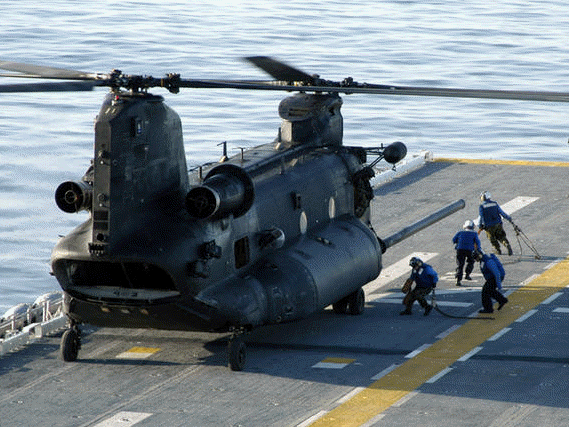
The Bell-Boeing team responded to criticism from Marines in Iraq about the V-22's dismal payload capacity. They recently announced a goal of increasing the V-22's engine power 20% - by improving software! This idea is so absurd that engineers either laugh or cry. The tiltrotor is a failed concept, which is why no airline or any other military organization has placed orders. If the V-22 were redesigned to include everything it needs for safe and reliable operations, it would gain so much weight that it would have zero payload.
The current spin is that the Marine Corps is committed to the V-22, so criticism helps no one and hurts morale. No matter how bad the V-22 performs, Marines have no choice but to shoulder the burden. That is an outright lie. The Corps has contracted for only half of the 360 V-22s it plans to buy. Since the V-22 has failed, it should be cancelled tomorrow. If the Commandant of the Marine Corps openly called for its cancellation in favor of CH-47Fs, MH-60Ss, or more CH-53Ks and UH-1Ys, it would be difficult for the "tiltrotor lobby" in Congress to win funding for more V-22s.
These proven helicopters are in production and are far superior alternatives to the V-22. The CH-47F would need minor modifications for shipboard use. However, Boeing developed these mods a decade ago for the Special Forces MH-47s (above). This is no surprise since Boeing built and supported the similar CH-46E for decades. However, the Marines have mostly operated from land the past decade, so they could take delivery of CH-47Fs coming off the Boeing assembly line. The Army may object, but they would rather the Marines support themselves in Afghanistan. This would be a simple transition for the hundreds of experienced CH-46E pilots and maintainers in the Marines.
This is politically possible since Boeing makes both the V-22 and CH-47F. The biggest obstacle is one of institutional egos. Marine Generals must admit the Corps made a mistake with the V-22. They don't have to say this publicly, but could spin it as a "budget driven" solution since the V-22 is so expensive. The V-22 was an interesting idea, but is a flawed design. Boeing knows this, which is why they have made no attempt to sell a commercial version. The V-22 failed many years ago, it is time for the Pentagon to acknowledge this fact.
Carlton Meyer editorG2mil@Gmail.com
©2010 www.G2mil.com